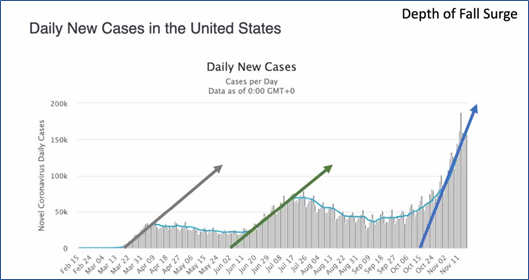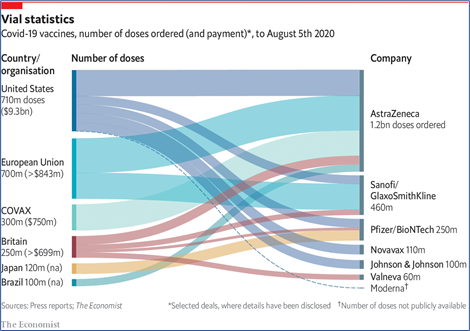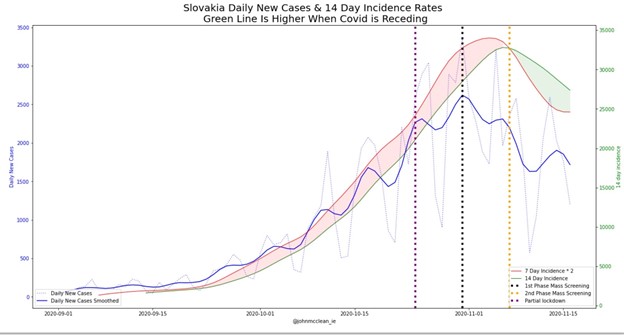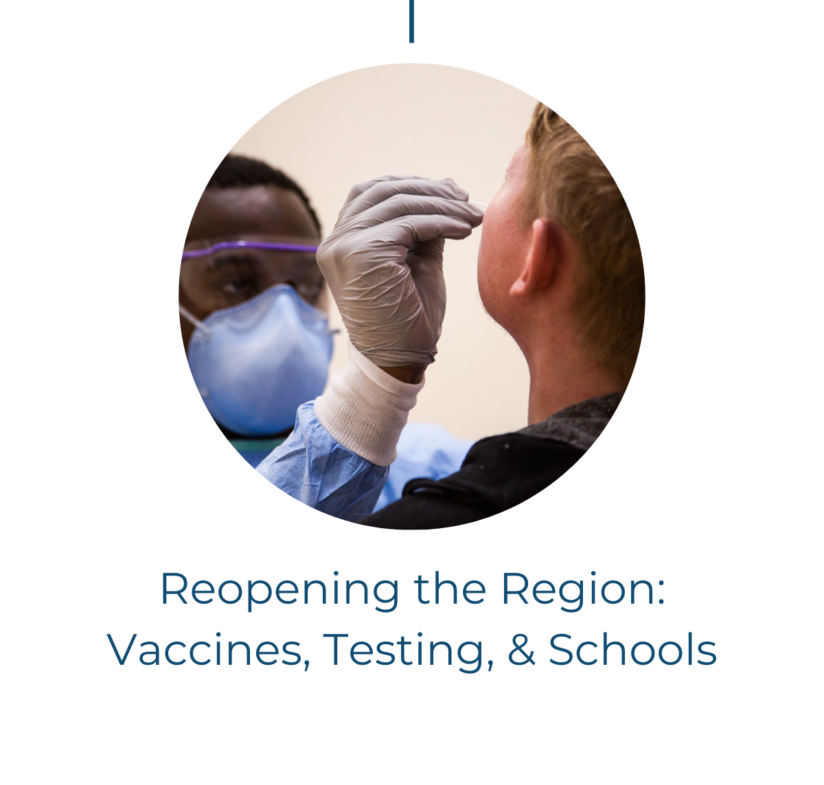Closing to Re-opening to Inclusive Recovery to Inclusive Growth
Before we start — support a frontline healthcare worker this week.

Source: White House Coronavirus Task Force
This week’s context feels like last week’s, only more so: continued political chaos and division at the national level combined with the worst health conditions in America since the Pandemic hit. While the Greater Capital Region continues to do a better job managing the virus, both Governors and D.C.’s Mayor have signaled we’re in for more rollbacks for some time.
At the same time, though, the light at the end of this viral tunnel is clearer than ever. Our best advice at the moment: join our webinar with some tremendous experts on all this and more – Monday, Nov. 23rd at 3 PM EST. Register here.
(Pre-read: Here’s where we are, where we’re going, and (special #nerdalert) a great Grand Rounds on Vaccines and Therapeutics by UCSF Dr. Bob Wachter if you want to dive deep.)
Let’s dig in.
VACCINES
The cavalry’s coming! And, it’s over the horizon and isn’t big enough to cover the entire battlefield yet…
Both the Pfizer and Moderna vaccines have now published efficacy at 95%, well beyond anyone’s expectation. Hug a scientist (virtually) – this is a remarkable, extraordinary achievement. Both filed for EUAs today. The FDA will likely take action on those during the second week of December.
Those two mRNA solutions may provide immunization for up to 20 million Americans by mid-January, and it’s believed they can collectively cover another 25 million or so for each of the following three months.

Source: National Academies of Sciences, Engineering, and Medicine
So, there is good reason to feel that by April, all of the National Academies’ Phase I priority for vaccination will be covered – about 15% of the American population. This would include frontline health workers and first responders (1a, those likely to be immunized in the next 60 days); then, people of all ages who are significantly higher risk (multiple comorbidities and underlying conditions) and older adults living in congregate or overcrowded settings.
But wait, there’s more! AstraZeneca, with more than 4,000 employees in our region, announced Phase II results that indicated high effectiveness and safety for their vaccine among the at-risk, over 65 population — the first of the leading providers to specifically address that question. They believe that they’ll be ready to apply for an EUA by the end of December. This could be a dramatic accelerant, as the U.S. has ordered almost half of Operation Warp Speed’s 710 million doses from AstraZeneca/Oxford.

Source: https://www.economist.com/graphic-detail/2020/08/07/the-case-for-splurging-on-covid-19-vaccines
And, more!! Recent studies suggest that COVID immunity may well last much longer than anticipated, too – possibly years, which would mean you won’t need regular update immunizations.
So … cavalry is coming, but it’s going to arrive in waves over the next year. Vaccines only work if they’re used. There is an increasingly acute need to accelerate distribution plans and to harmonize those across regions, and we stand ready to help that conversation, too. We need to prioritize and fund distribution planning. And, we need longer term resilience plans; this isn’t going to be our last public health emergency. As President Burwell of American University (and former head of HHS) – one of our panelists Monday – said, we need to be ready “when the next plague strikes — as it inevitably will. It is past time for the nation to make the investments we need to prevent, detect and respond quickly to emerging infectious diseases, like the coronavirus, before they sicken Americans and force catastrophic economic shutdowns.”
FFAST
Meanwhile, the consensus toward deploying fast, frequent, asymptomatic testing for all has accelerated as well. This headline – “Testing is Really Vaccination for the Economy’: We Need Millions and Millions of Rapid Tests – sums it up perfectly. As Duke University has shown, FFAST works. Drs. Fauci and Birx have jumped on the FFAST train, too!

Source: White House Office Coronavirus Task Force
China is showing the precise value in this approach – and its economy is rocketing ahead of the U.S. Slovakia is mass testing their entire population weekly – and it’s working to control the spread. Techniques are developing rapidly.

The FDA issued its first EUA for a home point-of-care COVID-19 test, which is some progress but slow – it’s only approved for symptomatic use when requested by a Doctor, and will cost $50 or more. Solutions exist; more are coming fast and cheaply:, and we are helping employers and public health folks throughout the region connect to them. We could have had them earlier, and we need to keep the push on to provide them now.
PUBLIC SCHOOLS
While the science continues to support opening schools first and closing them last, and the techniques and strategies to do so have become quite specific, operational, and clear (also, here), jurisdictions continue to struggle to finalize plans particularly as community spread accelerates. As the Superintendent of the L.A. Public Schools said this week, “Getting Kids Back to School has to be a Top Pandemic Priority.” More districts around the nation are adding FFAST to the reopening playbook. At the same time, more schools are pulling back in light right now due to rampant community spread. It’s important to know that at the moment it’s unlikely all kids and their families would be fully vaccinated before the end of 2021. We’ll need transition plans and infrastructure for the interim, as the current surge starts to subside.
WHAT IS GWP DOING ABOUT ALL THIS?
- We’re talking about it with some of the brightest minds. Attend our webinar on Monday November 23. Experts include AU President Sylvia M. Burwell; Dr. Stephen Jones, President and CEO of Inova, the region’s second largest health care system; Joe Ucuzoglu, CEO of Deloitte US; and Dr. Lynn Goldman, the Dean of the Milken School of Public Health at George Washington University. Master class, and we invite you to join the discussion!
- We continue to explore providing a scaled FFAST solution for the region that would supplement available testing and in particular would assist our public schools. We’re working closely with the Rockefeller Foundation, public health authorities, and our political leaders throughout the region on what can matter most here, while exploring innovating sources of supply and connecting those to demand. Our objective is to see whether philanthropy and business can, in combination, stand up a solution that will allow more of our public schools to reopen more quickly and safely, and not wait through 2021 for full vaccine distribution. We’ve been specifically asked about standing up a solution for teachers and staff first, with local public health moving toward FFAST for children and their families in parallel.
- We’re providing information that can help businesses, schools, and other entities make decisions about safe reopening. Use our new Inclusive Recovery Clearinghouse to track what we’re learning on all this in real-time.
FROM CLOSING TO REOPENING TO INCLUSIVE RECOVERY TO INCLUSIVE GROWTH
Our Partners believe that inclusion is the new innovation – that the region that develops the most inclusive economy will become the most attractive and fastest growing economy in the country.
Our path to that goal extends from reopening to inclusive recovery to inclusive growth. The pandemic is accelerating inequities; it is our responsibility to accelerate inclusive and equitable recovery.
We have some exciting initiatives underway around inclusive innovation and business building which we’ll be announcing soon. We were delighted to announce the stellar members of our Inclusive Growth Committee including some of the region’s most innovative and entrepreneurial community members.
In the meantime, we continue to actively champion the necessary infrastructure for our region to be the most inclusive economy. We co-hosted a great event last week with the Board of Trade with national and regional transportation leaders. Our work broadening and deepening the pipeline of digital talent for the region added more higher education and industry partners, as we explore opportunities around future now skills like blockchain and machine learning.
FORWARD FFASTER NOW
We believe that now is the perfect time to double down on collaborating to catalyze solutions that can scale for the Capital Region to become the world’s leader in inclusive growth. We know we’ll be beyond the pandemic soon, even as we need to be more careful and considerate now than ever (I’ve scotched my holiday travel plans and am looking forward to celebrating with friends and family in a few months). Now is the perfect time to accelerate into tomorrow’s promise.
Next week is Thanksgiving so we won’t be posting. But we will be donating, and hope you can, too. 54 million people in America have faced food insecurity during the pandemic. 1 in 8 Central Virginians is food insecure. Foodbanks throughout the region can use your help; in Baltimore, in northern and central Virginia, and in the Capital area.
Let’s do it!
Subscribe to receive future updates from JB Holston and the Capital Region.

